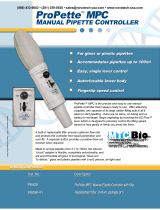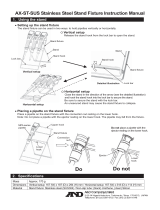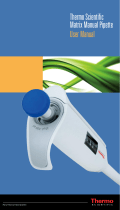
INTRODUCTION
5
PIPETMAN® CLASSIC | USER’S GUIDEINTRODUCTION | PIPETMAN® CLASSIC
Maximum Permissible Errors
The data provided in the following tables
conform to the ISO8655-2 standard. With
a precise pipetting technique (refer to
Guidelines for Good Pipetting on page 9), the
P2 model may be used to aspirate volumes as low
as 0.1 µL and the P10 model as low as 0.5 µL.
Figure 2
PIPETMAN® Classic single channel model
VOLUME
(µL)
GILSON ISO 8655
SYSTEMATIC
ERROR (µL)
RANDOM
ERROR (µL)
SYSTEMATIC
ERROR (µL)
RANDOM
ERROR (µL)
P2 (P/NF144801) WITH D10 OR DL10 TIPS
0.2 ± 0.024 ≤ 0.012 ± 0.08 ≤ 0.04
0.5 ± 0.025 ≤ 0.012 ± 0.08 ≤ 0.04
1 ± 0.025 ≤ 0.012 ± 0.08 ≤ 0.04
2 ± 0.030 ≤ 0.014 ± 0.08 ≤ 0.04
P10 (P/NF144802) WITH D10 OR DL10 TIPS
1 ± 0.025 ≤ 0.012 ± 0.12 ≤ 0.08
5 ± 0.075 ≤ 0.030 ± 0.12 ≤ 0.08
10 ± 0.100 ≤ 0.040 ± 0.12 ≤ 0.08
P20 (P/NF123600) WITH D200 TIPS
2 ± 0.10 ≤ 0.030 ± 0.2 ≤ 0.1
5 ± 0.10 ≤ 0.040 ± 0.2 ≤ 0.1
10 ± 0.10 ≤ 0.050 ± 0.2 ≤ 0.1
20 ± 0.20 ≤ 0.060 ± 0.2 ≤ 0.1
P100 (P/NF123615) WITH D200 TIPS
10 ± 0.35 ≤ 0.10 ± 0.8 ≤ 0.3
50 ± 0.40 ≤ 0.12 ± 0.8 ≤ 0.3
100 ± 0.80 ≤ 0.15 ± 0.8 ≤ 0.3
P200 (P/NF123601) WITH D200 TIPS
20 ± 0.50 ≤ 0.20 ± 1.6 ≤ 0.6
100 ± 0.80 ≤ 0.25 ± 1.6 ≤ 0.6
200 ± 1.60 ≤ 0.30 ± 1.6 ≤ 0.6
P1000 (P/NF123602) WITH D1000 TIPS
100 ± 3.0 ≤ 0.6 ± 8.0 ≤ 3.0
500 ± 4.0 ≤ 1.0 ± 8.0 ≤ 3.0
1000 ± 8.0 ≤ 1.5 ± 8.0 ≤ 3.0
P5000* (P/NF123603) WITH D5000 TIPS
500 ± 12 ≤ 3 ± 40 ≤ 15.0
2500 ± 15 ≤ 5 ± 40 ≤ 15.0
5000 ± 30 ≤ 8 ± 40 ≤ 15.0
P10mL* (P/NF161201) WITH D10mL TIPS
1000 ± 30 ≤ 6 ± 60 ≤ 30.0
2000 ± 30 ≤ 6 ± 60 ≤ 30.0
5000 ± 40 ≤ 10 ± 60 ≤ 30.0
10000 ± 60 ≤ 16 ± 60 ≤ 30.0
*P5000 and P10mL do not have tip ejectors.
























